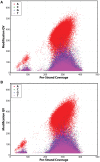A comparative analysis of methylome profiles of Campylobacter jejuni sheep abortion isolate and gastroenteric strains using PacBio data
- PMID: 25642218
- PMCID: PMC4294202
- DOI: 10.3389/fmicb.2014.00782
A comparative analysis of methylome profiles of Campylobacter jejuni sheep abortion isolate and gastroenteric strains using PacBio data
Abstract
Campylobacter jejuni is a leading cause of human gastrointestinal disease and small ruminant abortions in the United States. The recent emergence of a highly virulent, tetracycline-resistant C. jejuni subsp. jejuni sheep abortion clone (clone SA) in the United States, and that strain's association with human disease, has resulted in a heightened awareness of the zoonotic potential of this organism. Pacific Biosciences' Single Molecule, Real-Time sequencing technology was used to explore the variation in the genome-wide methylation patterns of the abortifacient clone SA (IA3902) and phenotypically distinct gastrointestinal-specific C. jejuni strains (NCTC 11168 and 81-176). Several notable differences were discovered that distinguished the methylome of IA3902 from that of 11168 and 81-176: identification of motifs novel to IA3902, genome-specific hypo- and hypermethylated regions, strain level variability in genes methylated, and differences in the types of methylation motifs present in each strain. These observations suggest a possible role of methylation in the contrasting disease presentations of these three C. jejuni strains. In addition, the methylation profiles between IA3902 and a luxS mutant were explored to determine if variations in methylation patterns could be identified that might explain the role of LuxS-dependent methyl recycling in IA3902 abortifacient potential.
Keywords: Campylobacter jejuni; LuxS; methylation; methylome; quorum sensing.
Figures





Similar articles
-
Multi-omics approaches to deciphering a hypervirulent strain of Campylobacter jejuni.Genome Biol Evol. 2013;5(11):2217-30. doi: 10.1093/gbe/evt172. Genome Biol Evol. 2013. PMID: 24201373 Free PMC article.
-
Role of metAB in Methionine Metabolism and Optimal Chicken Colonization in Campylobacter jejuni.Infect Immun. 2020 Dec 15;89(1):e00542-20. doi: 10.1128/IAI.00542-20. Print 2020 Dec 15. Infect Immun. 2020. PMID: 33046508 Free PMC article.
-
Key Role of Capsular Polysaccharide in the Induction of Systemic Infection and Abortion by Hypervirulent Campylobacter jejuni.Infect Immun. 2017 May 23;85(6):e00001-17. doi: 10.1128/IAI.00001-17. Print 2017 Jun. Infect Immun. 2017. PMID: 28373351 Free PMC article.
-
Campylobacter-Associated Diseases in Animals.Annu Rev Anim Biosci. 2017 Feb 8;5:21-42. doi: 10.1146/annurev-animal-022516-022826. Epub 2016 Nov 9. Annu Rev Anim Biosci. 2017. PMID: 27860495 Review.
-
[Occurrence and significance of different Campylobacter types in domestic animals in Hungary].Dtsch Tierarztl Wochenschr. 1990 Aug;97(8):317-21. Dtsch Tierarztl Wochenschr. 1990. PMID: 2209454 Review. German.
Cited by
-
Comparative Methylome Analysis of Campylobacter jejuni Strain YH002 Reveals a Putative Novel Motif and Diverse Epigenetic Regulations of Virulence Genes.Front Microbiol. 2020 Dec 23;11:610395. doi: 10.3389/fmicb.2020.610395. eCollection 2020. Front Microbiol. 2020. PMID: 33424813 Free PMC article.
-
Metaphenotypes associated with recurrent genomic lineages of Campylobacter jejuni responsible for human infections in Luxembourg.Front Microbiol. 2022 Sep 7;13:901192. doi: 10.3389/fmicb.2022.901192. eCollection 2022. Front Microbiol. 2022. PMID: 36160185 Free PMC article.
-
Whole-Genome Sequencing and Bioinformatic Analysis of Environmental, Agricultural, and Human Campylobacter jejuni Isolates From East Tennessee.Front Microbiol. 2020 Nov 5;11:571064. doi: 10.3389/fmicb.2020.571064. eCollection 2020. Front Microbiol. 2020. PMID: 33224113 Free PMC article.
-
The complete methylome of an entomopathogenic bacterium reveals the existence of loci with unmethylated Adenines.Sci Rep. 2018 Aug 14;8(1):12091. doi: 10.1038/s41598-018-30620-5. Sci Rep. 2018. PMID: 30108278 Free PMC article.
-
Molecular Mechanisms of Campylobacter Biofilm Formation and Quorum Sensing.Curr Top Microbiol Immunol. 2021;431:293-319. doi: 10.1007/978-3-030-65481-8_11. Curr Top Microbiol Immunol. 2021. PMID: 33620656 Review.
References
-
- Al-Maleki A. R., Mariappan V., Vellasamy K. M., Shankar E. M., Tay S. T., Vadivelu J. (2014). Enhanced intracellular survival and epithelial cell adherence abilities of Burkholderia pseudomallei morphotypes are dependent on differential expression of virulence-associated proteins during mid-logarithmic growth phase. J. Proteom. 106, 205–220. 10.1016/j.jprot.2014.04.005 - DOI - PubMed
-
- Anjum A. (2013). Mechanistic and Functional Analysis of Cj0031: a Phase Variable Methyltransferase in Campylobacter jejuni. Ph.D., University of Leicester.
LinkOut - more resources
Full Text Sources
Other Literature Sources
Molecular Biology Databases

